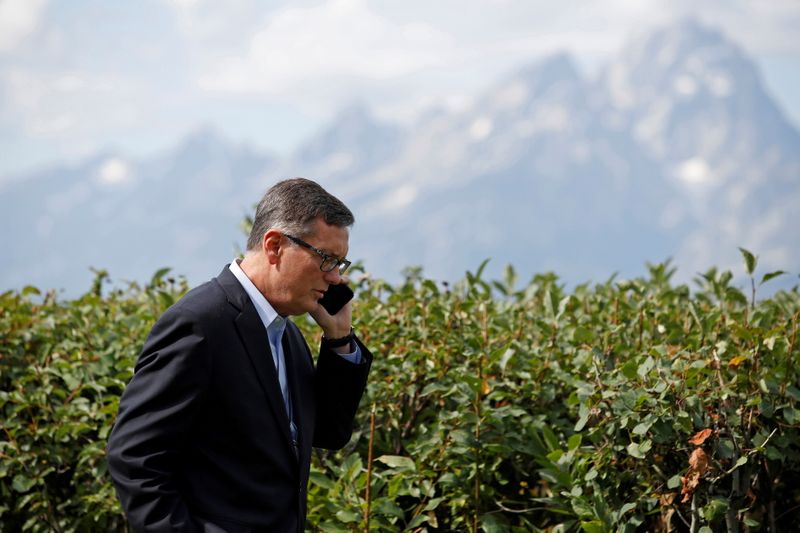By Lindsay (NYSE:LNN) Dunsmuir and Ann Saphir
(Reuters) -Three U.S. Federal Reserve policymakers on Tuesday said the economy has healed enough for the central bank to begin to withdraw its crisis-era support, cementing expectations the Fed will start to taper its monthly bond purchases as soon as next month.
"I myself believe that the 'substantial further progress' standard has more than been met with regard to our price-stability mandate and has all but been met with regard to our employment mandate," Fed Vice Chair Richard Clarida told the Institute of International Finance virtual annual meeting.
He was referring to the Fed's promise to keep buying $120 billion of Treasuries and mortgage-backed securities each month until the economy had met that standard on both its mandates.
Fed policymakers at their last meeting agreed that tapering "may soon be warranted" and would likely conclude in the middle of next year, he said.
Clarida's upbeat assessment likely echoes the sentiments of his boss, Fed Chair Jerome Powell, who previously said that he only needed to see a "decent" September U.S. jobs report to be ready to begin to taper bond buys in November.
The economy has strengthened and "conditions in the labor market have continued to improve," Clarida said, although he noted the pandemic continues to weigh on employment and participation.
Speaking in separate appearances on Tuesday, both Atlanta Fed President Raphael Bostic and St. Louis Fed President James Bullard said they also endorsed a November start.
"I think that the progress has been made, and the sooner we get moving on that the better," Bostic said in an interview with the Financial Times.
Bullard, speaking on CNBC, said he would like to wrap up the taper by the first quarter of 2022 so that if inflation stays high or goes even higher the Fed could raise rates "in the spring or summer if we had to do so."
But he also said that such a move need not come at the cost of gains in the labor market.
Employers added a smaller-than-expected 194,000 jobs last month, a Labor Department report showed. But Bullard said he expects growth to pick up in the fourth and first quarters, pushing the unemployment rate below 4% and to pre-pandemic levels by the spring.
Fed policymakers at their last meeting saw the unemployment rate falling to 4.8% by the end of this year, a benchmark Friday's report showed it had already reached last month.
SWEAR JAR
The Fed began buying bonds as part of its emergency response to the COVID-19 pandemic in March 2020 to stabilize financial markets and keep borrowing costs low.
Bostic said at a virtual event organized by the Peterson Institute for International Economics that financial markets now have plenty of liquidity, minimizing the odds that tapering the purchases will have an adverse effect on markets or the economy. "I actually think the economy has a lot of positive momentum," Bostic said.
Bullard agreed, saying that despite the recent surge in COVID-19 cases that slowed growth last quarter, the economy is in "great shape."
U.S. economic output has rebounded higher than pre-pandemic levels; Americans are sitting on at least $2.5 trillion in excess savings accumulated during the pandemic and consumer spending remains strong. Bond buys most directly affect demand whereas economies worldwide are struggling with labor and goods shortages.
Indeed, the surge in demand as the U.S. economy reopened has caused a spike in inflation with persistent supply bottlenecks set to keep price increases well above the Fed's 2% average inflation goal through the end of the year and into 2022. That has raised fear of a 1970s-style "stagflation," where economic growth grinds to a halt but inflation keeps rising.
Fed policymakers on Tuesday said that's not their expectation.
"The big unknown right now is how long it will take for these bottleneck effects to work their way through," Clarida said in a question and answer session, but the expectation is that they will recede. "My baseline case is not for stagflation over the medium horizon."
And though analysts have raised the possibility that rising inflation could force the central bank to raise interest rates from near zero before the labor market is fully healed, Clarida and other policymakers played down that possibility.
"The risks to inflation are to the upside," Clarida acknowledged but said he still believes the upward impulse is "transitory," with inflation expectations anchored and rising wages not feeding a worrisome upward price spiral.
Bostic for his part joked that at his bank anyone using the word "transitory" to describe inflation has to put $1 in a swear jar, because the current episode of rising prices is proving to be far from brief.
Still, he said, he does not expect high inflation to persist or cause lasting damage to the economy that "would really call into question our policy stance in terms of interest rates."
It will be more than a year before the central bank will need to raise rates from near zero levels, he said.
